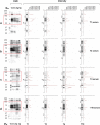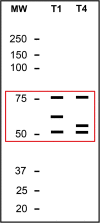Differentiation of Trichinella species (Trichinella spiralis/Trichinella britovi versus Trichinella pseudospiralis) using western blot
- PMID: 30541617
- PMCID: PMC6291991
- DOI: 10.1186/s13071-018-3244-3
Differentiation of Trichinella species (Trichinella spiralis/Trichinella britovi versus Trichinella pseudospiralis) using western blot
Abstract
Background: Trichinellosis is a meat-borne zoonotic disease caused by parasites of the genus Trichinella. To date, 12 taxa have been described. The identification of Trichinella species is crucial in order to identify the possible source of infection, the geographical origin of the parasite and to assess risk of infection for domestic pigs and humans. Specific identification of the etiological agent is not always feasible using direct methods since the source of infection can be untraceable. The aim of this study was to develop a diagnostic tool to infer the causative Trichinella species using western blot patterns of sera derived from infected animal and human hosts.
Methods: Sera from mice experimentally infected with Trichinella spiralis, Trichinella britovi, Trichinella pseudospiralis and Trichinella papuae were tested by western blot using homologous and heterologous crude worm extracts (CWE) and a highly sensitive detection system based on chemiluminescence. In addition, sera from pigs experimentally infected with T. spiralis, T. britovi and T. pseudospiralis and from patients with confirmed T. spiralis, T. britovi and T. pseudospiralis infections, were also included.
Results: Sera from mice infected with one Trichinella species reacted with CWE proteins from all four investigated species. Likewise, sera derived from pigs and humans infected with one Trichinella species reacted with CWE proteins from all the three investigated species. Using T. spiralis CWE, sera from T. pseudospiralis-infected hosts yielded a characteristic pattern of reactivity using Wb, which differed to that produced by T. spiralis/T. britovi- or T. papuae-infected host sera.
Conclusions: The present study suggests that western blot using T. spiralis CWE may be a useful tool to distinguish Trichinella infections caused by T. pseudospiralis from those caused by T. spiralis or T. britovi. This method may support epidemiological investigations, particularly when the source of infection is not traceable.
Keywords: Crude worm extract; Diagnosis; Epidemiology; Serology; Trichinella; Western blot.
Conflict of interest statement
Ethics approval and consent to participate
Mice and pigs were housed and treated according to the European directive on laboratory animal welfare (European Commission, 2010 and L.D. 26/2014) and the protocols were approved by the Italian Ministry of Health (DL 116/92 and 11/2016 UT, respectively). All of the human participants provided informed consent to have blood samples drawn.
Consent for publication
Not applicable.
Competing interests
The authors declare that they have no competing interests.
Publisher’s Note
Springer Nature remains neutral with regard to jurisdictional claims in published maps and institutional affiliations.
Figures






Similar articles
-
Evaluation of a Western Blot and ELISA for the detection of anti-Trichinella-IgG in pig sera.Vet Parasitol. 2009 Aug 26;163(4):341-7. doi: 10.1016/j.vetpar.2009.04.034. Epub 2009 May 4. Vet Parasitol. 2009. PMID: 19473770
-
Acute phase protein pattern and antibody response in pigs experimentally infected with a moderate dose of Trichinella spiralis, T. britovi, and T. pseudospiralis.Vet Parasitol. 2020 Dec;288:109277. doi: 10.1016/j.vetpar.2020.109277. Epub 2020 Oct 22. Vet Parasitol. 2020. PMID: 33130498
-
Detection of Trichinella spiralis, T. britovi and T. pseudospiralis in muscle tissue with real-time PCR.J Microbiol Methods. 2008 Oct;75(2):287-92. doi: 10.1016/j.mimet.2008.06.019. Epub 2008 Jun 26. J Microbiol Methods. 2008. PMID: 18639594
-
[Methods and tools for parasite differentiation within the genus Trichinella].Wiad Parazytol. 2006;52(3):165-73. Wiad Parazytol. 2006. PMID: 17432239 Review. Polish.
-
[Trichinellosis outbreaks in Spain (1990-2001)].Enferm Infecc Microbiol Clin. 2004 Feb;22(2):70-6. doi: 10.1157/13056885. Enferm Infecc Microbiol Clin. 2004. PMID: 14756987 Review. Spanish.
Cited by
-
Trichinellosis dissemination among wild carnivores in the Republic of Kazakhstan: A 10-year study.Vet World. 2023 Sep;16(9):1840-1848. doi: 10.14202/vetworld.2023.1840-1848. Epub 2023 Sep 14. Vet World. 2023. PMID: 37859970 Free PMC article.
-
AxiWorm: a new tool using YOLOv5 to test antiparasitic drugs against Trichinella spiralis.Parasit Vectors. 2025 Feb 2;18(1):36. doi: 10.1186/s13071-025-06664-8. Parasit Vectors. 2025. PMID: 39894842 Free PMC article.
-
Accreditation Procedure for Trichinella spp. Detection in Slaughterhouses: The Experience of an Internal Laboratory in Italy.Foods. 2019 Jun 6;8(6):195. doi: 10.3390/foods8060195. Foods. 2019. PMID: 31174391 Free PMC article.
-
Epidemiological perspective associated with principal risk factors of Trichinella spiralis infection in pigs and humans in Egypt.Vet World. 2022 Jun;15(6):1430-1437. doi: 10.14202/vetworld.2022.1430-1437. Epub 2022 Jun 11. Vet World. 2022. PMID: 35993072 Free PMC article.
-
Serological testing for Trichinella infection in animals and man: Current status and opportunities for advancements.Food Waterborne Parasitol. 2022 May 13;27:e00165. doi: 10.1016/j.fawpar.2022.e00165. eCollection 2022 Jun. Food Waterborne Parasitol. 2022. PMID: 35601880 Free PMC article.
References
-
- Dupouy-Camet J, Bruschi F. Management and diagnosis of human trichinellosis. In: Dupouy-Camet J, Murrell KD, editors. FAO/WHO/OIE guidelines for the surveillance, management, prevention and control of trichinellosis. 1. Paris: FAO/WHO/OIE; 2007. pp. 37–68.
Publication types
MeSH terms
Substances
Grants and funding
LinkOut - more resources
Full Text Sources

